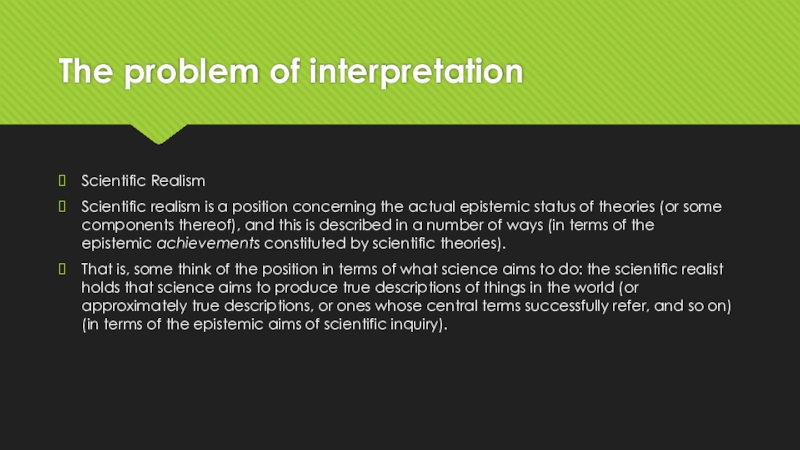Разделы презентаций
- Разное
- Английский язык
- Астрономия
- Алгебра
- Биология
- География
- Геометрия
- Детские презентации
- Информатика
- История
- Литература
- Математика
- Медицина
- Менеджмент
- Музыка
- МХК
- Немецкий язык
- ОБЖ
- Обществознание
- Окружающий мир
- Педагогика
- Русский язык
- Технология
- Физика
- Философия
- Химия
- Шаблоны, картинки для презентаций
- Экология
- Экономика
- Юриспруденция
Methodical Problems of Comparative Studies
Содержание
- 1. Methodical Problems of Comparative Studies
- 2. PlanThe problem of comparisonThe problem of equivalenceThe
- 3. Слайд 3
- 4. The problem of equivalenceStegmueller, D.
- 5. The problem of equivalenceThe problem
- 6. The problem of equivalenceIn some
- 7. The problem of universalityStrategies to deal with this problem are available:The Ladder of AbstractionRetest
- 8. “Small N, large-V” problemWith each additional explanatory
- 9. The Galton’s problemSir Francis Galton was an
- 10. The Galton’s problemLack of independence between
- 11. The problem of measurementCommon to all fields of research
- 12. The problem of interpretationMultiple meanings of
- 13. The problem of interpretationScientific RealismScientific realism is
- 14. Скачать презентанцию
PlanThe problem of comparisonThe problem of equivalenceThe problem of universality“Small N, large-V” problemThe Galton’s problemThe problem of measurementThe problem of interpretation
Слайды и текст этой презентации
Слайд 2Plan
The problem of comparison
The problem of equivalence
The problem of universality
“Small
N, large-V” problem
interpretationСлайд 3
The problem of comparison
No two things in the world are
identical, and therefore comparative politics runs into a difficulty when
it wants to compare the ‘same phenomena’ or ‘similar objects’ in different countries.Two strategies to deal with this problem are available:
• looking for more abstract concepts
• looking for equivalent concepts
Слайд 4
The problem of equivalence
Stegmueller, D. (2011). Apples and Oranges? The
Problem of Equivalence in Comparative Research. Political Analysis, 19(4). P. 473.
Слайд 5
The problem of equivalence
The problem is depicted in ideal-typical form
in Fig. 1 . Panel A shows a comfortable state
of the survey research world where no item bias exists. That an individual j living in country k responds differently from an individual living in country к' is completely due to the fact that they have different preferences (njk != n’jk’). Panel В shows the opposite situation. Now our two individuals share the same level of preference or attitude strength (njk = njk’), but their responses differ due to the systematic country differences discussed above. Clearly, the differences between those individuals are not real but the result of country method effects, so that latent preferences cannot be compared between countries.Слайд 6
The problem of equivalence
In some countries, individuals are predominantly acquiescent,
that is, they have a tendency to select only one
side of the scale (usually the one indicating agreement). Some countries produce extreme responders, who consistently choose extreme ends of scales, whereas in other countries, individuals predominantly choose the middle part of a response scale - avoiding strong statements (Yang et al. 2010). In consequence, this means that two individuals sharing the same level of preference may answer survey questions differently, simply because one of them is from a country where an extreme response style is common. Scores from individuals from different countries are then no longer directly comparable since they are systematically biased (Millsap and Kwok 2004). In other words, the dependent variable lacks equivalence.Слайд 7
The problem of universality
Strategies to deal with this problem are
available:
The Ladder of Abstraction
Retest
Слайд 8“Small N, large-V” problem
With each additional explanatory variable (V) the
number of cases (n) required for comparisons grows exponentially. Therefore,
only a few explanatory variables are often too many for the relatively small number of cases available, in which case an empirical test is not possible.Strategies to deal with this problem are available:
increase the number of cases;
limiting the number of variables.
Слайд 9The Galton’s problem
Sir Francis Galton was an English Victorian era
statistician, progressive, polymath, sociologist, psychologist, anthropologist, eugenicist, tropical explorer, geographer,
inventor, meteorologist, proto-geneticist, and psychometrician.Слайд 10
The Galton’s problem
Lack of independence between two cases presents two
problems. First, it might bias the results; second, it affects
statistical analyses by making the size of the sample of independent cases uncertain.Слайд 12
The problem of interpretation
Multiple meanings of the same political phenomenon
Two
strategies to deal with this problem are available:
To change attitude
towards history and histortical methodScientific Realism
Слайд 13The problem of interpretation
Scientific Realism
Scientific realism is a position concerning
the actual epistemic status of theories (or some components thereof),
and this is described in a number of ways (in terms of the epistemic achievements constituted by scientific theories).That is, some think of the position in terms of what science aims to do: the scientific realist holds that science aims to produce true descriptions of things in the world (or approximately true descriptions, or ones whose central terms successfully refer, and so on) (in terms of the epistemic aims of scientific inquiry).































